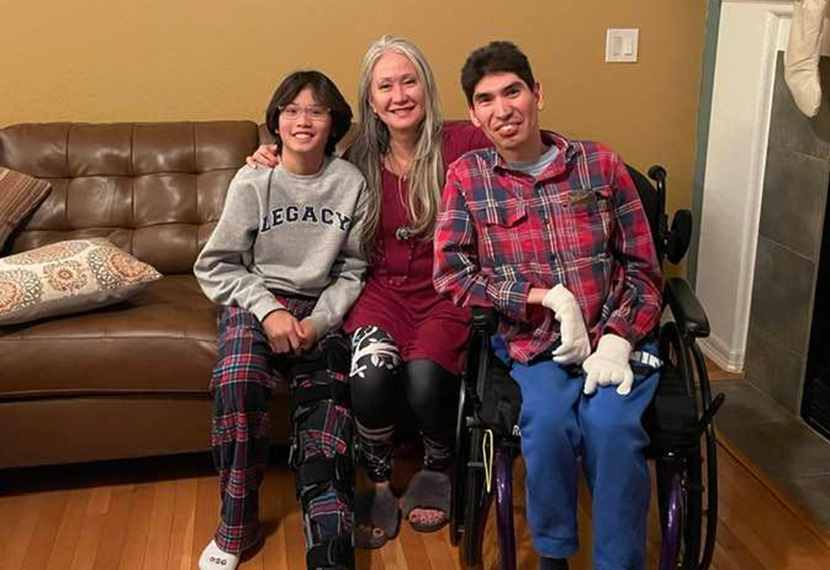By day, Bella Bates juggles many roles. The Broomfield resident is a full-time caregiver for her adult son. When not attending to his needs, she runs an apothecary business, is a master seamstress, chauffeurs her teenage son to swim practice and helps her eldest daughter with her two young children. Despite her busy schedule, Bella knew she couldn't ignore the pelvic pain and abnormal symptoms she experienced after menopause.
"For the past seven years, I had been experiencing on and off abnormal pelvic pain and irregular bleeding. I had undergone multiple dilation and curettage (D&C) procedures due to abnormal growth of uterine tissue," shares Bella. "When perimenopause hit and ultimately menopause, I expected these symptoms to stop."
A pelvic ultrasound revealed a solid mass on Bella's left ovary, alarming her healthcare providers. The 53-year-old had a history of benign cysts on her ovaries. But this scan differed as the mass appeared solid instead of fluid-filled like her past cysts.
Faced with the concerning finding, her doctor referred Bella to Dr. Kian Behbakht, a gynecologic oncologist and CU Medicine provider.
Dr. Behbakht is a professor and surgeon in the department of obstetrics and gynecology at the University of Colorado School of Medicine, and his interests are in cancer prevention, early detection and cutting-edge cancer treatments.
"The reason for referral was that Bella had a solid mass growing on her ovary," shares Dr. Behbakht. "This was concerning enough because it had persisted."
Getting answers
The first test Bella did was a blood test called a CA 125, which is often abnormally elevated in ovarian cancers. Thankfully, her test was normal, but that didn't rule out the chance of a malignancy in her ovary.

The conclusion was made to remove one or both ovaries at the very least. Given Bella's symptoms, desire to not continue doing D&Cs, or experience uterine bleeding while taking multiple replacement hormones and the fact that she was done childbearing, she decided on getting a full hysterectomy, with the additional removal of both ovaries and her uterus.
Risk-reducing hysterectomy and bilateral salpingo-oophorectomy (BSO)
A risk-reducing hysterectomy and BSO is a pre-emptive surgery to remove the uterus and ovaries and fallopian tubes for women at higher risk of ovarian and uterine cancer. It is an option for those with genetic mutations like BRCA1 and BRCA2 that greatly increase the chances of developing these gynecologic cancers.
Hysterectomy and BSO aims to prevent such cancers before they can start. Ovarian cancer in particular is still not caught early, and the late stages are particularly deadly. The decision to remove the ovaries, fallopian tubes, and uterus involves weighing the pros and cons with a doctor based on the patient's individual inherited cancer risk, family history and priorities around preventing cancer versus keeping her reproductive organs.
While Bella didn’t have known gene mutations, she opted to have an elective full hysterectomy to accomplish her goals of living pain and worry-free.
Know the symptoms of ovarian cancer
Ovarian cancer may cause vague or no symptoms in its early stages, making it difficult to detect. However, women should watch for potential signs and report them promptly to their doctors.
The most common ovarian cancer symptoms include:
Bloating or a feeling of fullness in the abdominal area
Pelvic or abdominal pain
Difficulty eating or feeling full quickly
Other potential signs are:
Urinary urgency or frequency
Fatigue
Upset stomach or heartburn
Back pain
Constipation or menstrual changes
These tend to be persistent and represent a change from a woman's normal experiences. The symptoms may be caused by something other than cancer, but it's important they get evaluated.
Ovarian cancer is most curable when treated in its earliest stages. Women, especially over age 50, should educate themselves on the subtle signs and see a gynecologist promptly about any new, recurrent or worsening symptoms.
Shout about ovarian cancer
When asked about ovarian cancer detection, Dr. Behbakht's message is simple: "Let's shout about ovarian cancer, not whisper. The tagline used to be, 'Ovarian cancer whispers, so listen.' The whisper being the subtle signs of ovarian cancer."
Dr. Behbakht counters the old adage by asking patients to talk to their friends, family members and anyone they know experiencing subtle signs of ovarian cancer. He wants them to encourage those people to speak with their gynecologists and primary care providers about ruling out the disease. Consultation with a gynecologic oncologist, a specialist in these cancers may be needed, and Dr. Behbakht is one of the many CU faculty that lead nationally in investigating the latest in the early diagnosis and treatment of these cancers.
It has been over a year since Bella's hysterectomy, and when asked how she feels today, she shares, "I have absolutely no regrets when it comes to my decision to get a full hysterectomy. I allowed myself to process it, gave myself grace when I was recovering, and have total peace of mind now."

